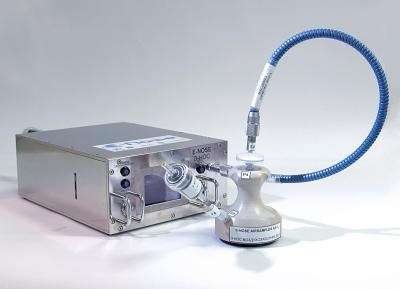Mon, Dec 17, 2012
Astrium Instrument To ‘Sniff Out’ Dangers To Health Of ISS Crew
When the next crew of the International Space Station (ISS) sets off into space aboard a Soyuz spacecraft on December 19, their luggage will contain an electronic nose developed by Astrium. This ‘E-Nose’, as it is called, will measure the crew’s exposure to bacteria and fungi in the Russian segment of the space station from 2013.

E-Nose will detect microbiological hazards from bacterial and fungal cultures using qualitative and quantitative methods. Monitoring is essential as excessive exposure to fungi and bacteria poses a not inconsiderable risk to both the on-board technology and the health of the crew. This specially developed analytical instrument allows cosmonauts to carry out measurements in every location of the ISS Service Module. Also in the luggage will be a ‘target book’ containing various material samples (aluminium, PCB material, cable marking material, and Nomex, a special flame-resistant clothing material which is used to make the suits worn by fire fighters and racing drivers). Biological cultures can colonize these materials. Their presence will be measured by the cosmonauts at two-month intervals. On completion of a measurement cycle lasting about six months, the target book will be sent back to Earth, where the samples will be evaluated by the Moscow-based Institute for Biological and Medical
Problems (IBMP) in cooperation with EADS Innovation Works, the corporate research organization of EADS.
The measurement system built by Astrium is called an electronic nose because it records specific odour patterns using ten different semiconductor sensors. The system takes advantage of the distinctive properties of the gas molecules emitted by the biological cultures. These molecules are produced by the metabolisms of the biological cultures, and are species-specific. Scientists in the laboratory down on Earth can create specific odour patterns based on the different ways in which individual sensors are stimulated. The data measured on the space station will then be compared against the data from the cultures ‘trained’ on Earth in order to find correlations.
The conventional sampling method (swipe sample) with subsequent ‘processing’ in an incubator would require expert knowledge and be very time-consuming in the ISS, whereas the new E-Nose enables a prompt analysis of the situation thanks to its data connection to the ground station.
“In the long run, the E-Nose will make an important contribution to ensuring the safety of the crew on board the ISS. This applies both to the entire space station and also to possible long-term missions (e.g. to Mars),” says Astrium project manager Thomas Hummel. There are also potential applications for the E-Nose down on Earth, e.g. on commercial passenger aircraft or submarines.
E-Nose is a German Aerospace Center (DLR) project, with Astrium as prime contractor.
(Image provided by Astrium)
More News
Aviation Governance Secured...At Least For a While The National Business Aviation Association similarly applauded the passage of the FAA's recent reauthorization, contentedly recou>[...]
Emphasis On Growing The Future of Aviation Through Concentration on 'AFFORDABLE FLYERS' It's been a number of years since the Latest Edition of Jim Campbell's HUGE SportPlane Resou>[...]
Amazilia Aerospace GmbH, Develops Digital Flight Control, Flight Guidance And Vehicle Management Systems Textron eAviation has acquired substantially all the assets of Amazilia Aer>[...]
Honeywell's Primus Brings New Tools and Niceties for Hawker Operators Hawker 4000 business jet operators have a new installation on the table, now that the FAA has granted an STC f>[...]
Company Celebrates Niche-but-Important Advancement in Industry Standards Echodyne has announced full integration of its proprietary 'EchoFlight' radar into the e American Aerospace>[...]
 Bolen Gives Congress a Rare Thumbs-Up
Bolen Gives Congress a Rare Thumbs-Up The SportPlane Resource Guide RETURNS!!!!
The SportPlane Resource Guide RETURNS!!!! Buying Sprees Continue: Textron eAviation Takes On Amazilia Aerospace
Buying Sprees Continue: Textron eAviation Takes On Amazilia Aerospace Hawker 4000 Bizjets Gain Nav System, Data Link STC
Hawker 4000 Bizjets Gain Nav System, Data Link STC Echodyne Gets BVLOS Waiver for AiRanger Aircraft
Echodyne Gets BVLOS Waiver for AiRanger Aircraft



